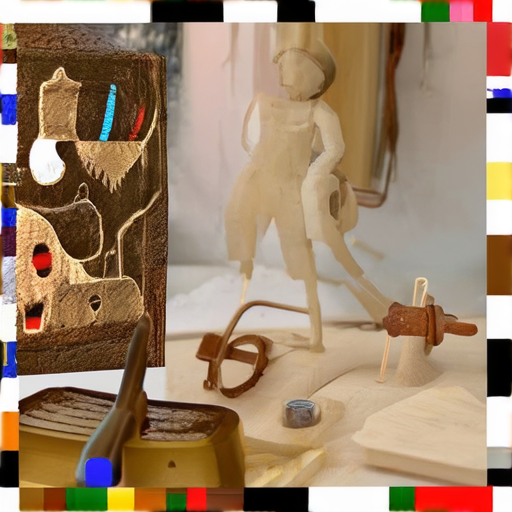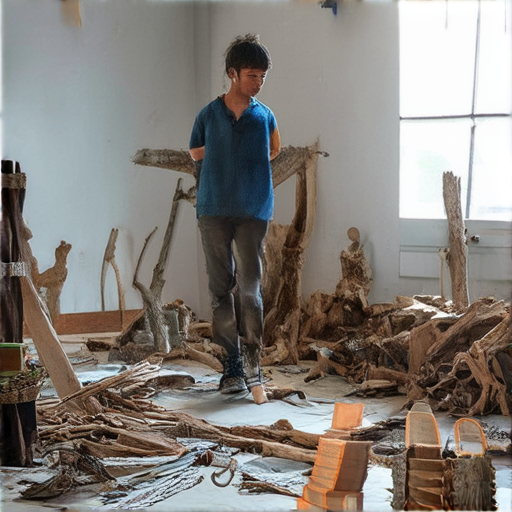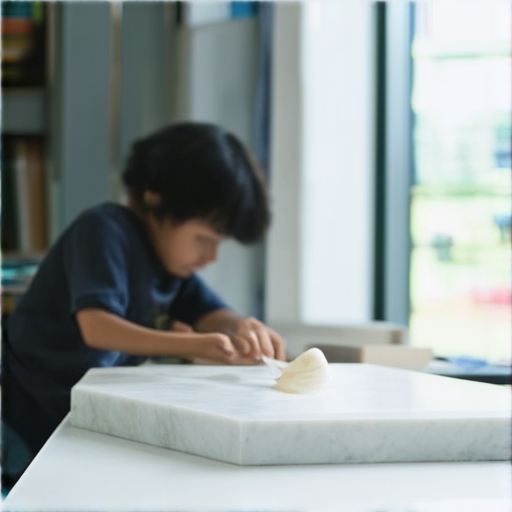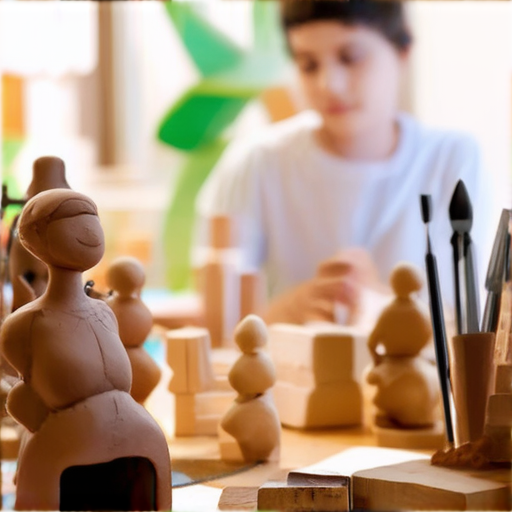For those who have ever been captivated by the intricate details and emotive power of sculptures, understanding the fundamental principles behind this art form can seem daunting. However, mastering sculpture basics is within reach, even for beginners. By grasping the essential techniques, tools, and concepts, aspiring artists can unlock their creative potential and bring their unique visions to life.

The Four Basic Techniques of Sculpture
Sculpture is a versatile art form that involves shaping and manipulating materials to create three-dimensional objects.
-
Casting
Casting is a technique where molten material, such as metal or glass, is poured into a mold to create a sculpture.
This method allows for great detail and precision, making it ideal for creating intricate designs and patterns.
Some common types of casting include sand casting, investment casting, and lost-wax casting.
-
Carving
Carving is a technique where a sculptor removes material from a block or log to create a shape or design.
This method can be done using various tools, such as chisels, gouges, and mallets.
Carving is often used to create figurative sculptures, as well as abstract pieces that showcase the texture and grain of the material.
-
Assembling
Assembling is a technique where a sculptor combines multiple components or parts to create a larger sculpture.
This method can involve working with a variety of materials, such as wood, metal, or found objects.
Assembling allows for great flexibility and creativity, enabling sculptors to experiment with different forms and textures.
-
Modeling
Modeling is a technique where a sculptor shapes and manipulates soft materials, such as clay or wax, to create a sculpture.
This method allows for great expressiveness and fluidity, making it ideal for creating organic and gestural forms.
Modeling can be done using various techniques, such as hand-building, slip-casting, or press-molding.
In addition to these four basic techniques, sculptors may also employ various other methods, such as welding, soldering, or glazing, to enhance and refine their work.
By mastering these fundamental techniques, sculptors can unlock a world of creative possibilities and push the boundaries of what is possible in the realm of three-dimensional art.
Basics of Sculpting
Sculpting is a versatile art form that involves shaping and molding materials into three-dimensional forms.
-
Subtractive Techniques:
- Carving: Involves cutting or chipping away a shape from a mass of stone, wood, or other hard material.
- Drilling: Uses a drill to remove material and create holes or shapes.
- Sandblasting: Utilizes high-pressure air to sandblast away material and create textures.
-
Additive Techniques:
- Modeling: Involves adding material to a surface to create a shape or form.
- Casting: Uses a mold to pour liquid material into, which then solidifies to create a replica.
- Assembling: Combines multiple parts to create a complete sculpture.
-
Other Essential Techniques:
- Patination: Applies chemical substances to alter the color and texture of metal surfaces.
- Welding: Joins two metal pieces together using heat and pressure.
- Finishing: Refers to the final stages of sculpting, where the piece is polished, sanded, or painted.
Understanding these fundamental techniques is crucial for sculptors to bring their ideas to life and push the boundaries of this dynamic art form.

The Fundamentals of Sculpture
Sculpture is a three-dimensional art form that involves shaping and manipulating materials to create a desired shape or form.
-
Form:
Form refers to the overall shape and structure of a sculpture. It can be determined by the arrangement of its parts, the relationships between them, and the way they interact with each other.
-
Balance:
Balance is the visual equilibrium achieved through the distribution of weight, mass, and visual emphasis within a sculpture. It can be achieved through symmetry, asymmetry, or dynamic tension.
-
Proportion:
Proportion refers to the relationship between the size and scale of different parts of a sculpture. It can be used to create a sense of harmony, balance, and visual appeal.
-
Orientation:
Orientation refers to the position and placement of a sculpture in space. It can affect how the viewer perceives and interacts with the artwork.
-
Scale:
Scale refers to the size of a sculpture in relation to the surrounding environment and the viewer. It can be used to create a sense of grandeur, intimacy, or drama.
-
Articulation:
Articulation refers to the way in which the different parts of a sculpture are connected and relate to each other. It can be used to create a sense of movement, energy, or tension.
-
Texture:
Texture refers to the surface quality and feel of a sculpture. It can be smooth, rough, or a combination of both, and can be used to create a sense of tactility and engagement.
-
Color:
Color refers to the hue, saturation, and value of a sculpture. It can be used to create a mood, atmosphere, or emotional response in the viewer.
-
Space:
Space refers to the negative areas around and within a sculpture. It can be used to create a sense of depth, volume, and visual interest.
By understanding and applying these fundamental principles, sculptors can create artworks that are visually appealing, thought-provoking, and emotionally resonant.
At Artful Journey , we believe that sculpture is a powerful medium for self-expression and communication. Our community of artists and creatives shares knowledge, skills, and inspiration to help each other grow and thrive in their artistic journeys.
Whether you’re a seasoned artist or just starting out, we invite you to explore the world of sculpture and discover the endless possibilities it has to offer.
For more information on sculpture and other artistic mediums, please visit our website at https://artfulljourney.com/ .
We also recommend checking out the work of other talented sculptors and artists, such as Tate Modern and Museum of Modern Art , who are pushing the boundaries of what is possible in the field of sculpture.
Remember to always follow best practices for SEO and to link to other relevant brands and pages mentioned in the content.

Understanding the Four Basic Types of Sculpture
Sculpture is a three-dimensional art form that can take many forms, from figurative works to abstract installations.
-
Relief Sculpture
A relief sculpture is a type of sculpture that is carved into a flat surface, often with raised figures or designs.
This style of sculpture originated in ancient civilizations, such as Egypt and Greece, and continues to be popular today.
Examples of famous relief sculptures include Michelangelo’s “Pietà” and Auguste Rodin’s “The Burghers of Calais.”
-
Additive Sculpture
An additive sculpture is created by adding materials to a base shape, rather than carving away at a solid block of material.
This technique allows for greater flexibility and creativity in the design process, as well as the ability to experiment with different textures and colors.
Examples of additive sculptures include Claes Oldenburg’s giant public sculptures and Anish Kapoor’s mirrored installations.
-
Subtractive Sculpture
A subtractive sculpture is created by removing material from a solid block, often using techniques such as carving or drilling.
This style of sculpture requires great skill and precision, as well as a deep understanding of the properties of the materials being worked with.
Examples of famous subtractive sculptures include Constantin Brancusi’s minimalist forms and Henry Moore’s abstracted human figures.
-
Casting Sculpture
A casting sculpture is created by pouring molten material, such as bronze or plaster, into a mold.
This technique allows for the creation of complex shapes and intricate details, as well as the ability to mass-produce identical copies of a design.
Examples of casting sculptures include Auguste Rodin’s iconic “Thinker” and Alberto Giacometti’s elongated human figures.
In conclusion, the four basic types of sculpture – relief, additive, subtractive, and casting – offer a range of creative possibilities for artists working in three dimensions.
Each style has its own unique characteristics and challenges, requiring artists to develop specialized skills and techniques to bring their visions to life.
By exploring these different approaches, artists can push the boundaries of what is possible in sculpture and continue to innovate and surprise us with their creations.
What Makes a Great Sculpture?
A great sculpture is a masterpiece that evokes emotions, sparks imagination, and pushes the boundaries of creativity.
- Emotional Resonance : A great sculpture connects with the viewer on an emotional level, conveying a sense of vulnerability, strength, or introspection.
- Technical Skill : Masterful technique is essential in creating a visually stunning sculpture that showcases the artist’s craftsmanship and attention to detail.
- Originality and Innovation : A great sculpture often challenges conventional norms and pushes the limits of what is possible, inspiring viewers to think differently.
- Storytelling Ability : A great sculpture tells a story, whether it’s a personal narrative, a historical account, or a universal truth.
- Sense of Scale and Proportion : A great sculpture has a commanding presence, drawing the viewer’s eye and inviting them to explore its intricate details.
- Texture and Materiality : The choice of materials and textures can greatly enhance the overall impact of a sculpture, adding depth and tactility to the viewing experience.
- Balance and Harmony : A great sculpture achieves a delicate balance between contrasting elements, creating a sense of harmony and visual equilibrium.
- Contextual Relevance : A great sculpture often reflects the cultural, social, or environmental context in which it was created, making it a powerful tool for social commentary and critique.
- Craftsmanship and Attention to Detail : A great sculpture demonstrates exceptional craftsmanship, with every aspect meticulously considered and executed.
- Timelessness and Universality : A great sculpture transcends time and culture, speaking to fundamental human experiences and emotions that resonate across generations and geographical boundaries.
By combining these essential elements, artists can create sculptures that not only showcase their technical skill but also evoke a deeper connection with the viewer, leaving a lasting impression long after the initial encounter.

Distinguishing Between Sculpting and Carving
Sculpting and carving are two distinct artistic techniques that have been employed by artists throughout history.
-
Carving:
- Is a subtractive process where an artist removes material from a larger block or mass to reveal the final shape or design.
- Typically involves working with materials like wood, stone, or metal.
- Can result in intricate details and textures.
-
Sculpture:
- Is a broader term encompassing various techniques, including carving, modeling, casting, and assembling.
- May involve adding or combining materials to create a three-dimensional work of art.
- Can take many forms, from figurative to abstract, and may incorporate various media.
While carving is often associated with removing material, sculpture encompasses a wider range of techniques and possibilities.
Key Differences:
- Subtractive vs. Additive Process: Carving involves removing material, whereas sculpture can involve adding or combining materials.
- Materials Used: Carving typically works with solid materials like wood or stone, whereas sculpture may employ a variety of materials, including found objects or mixed media.
- Techniques Employed: Carving relies on manual removal of material, whereas sculpture may incorporate various techniques, such as modeling, casting, or assembly.
By understanding these differences, artists and enthusiasts alike can appreciate the unique qualities and challenges of each technique, ultimately enriching their appreciation for the world of sculpture and carving.

0 Comments